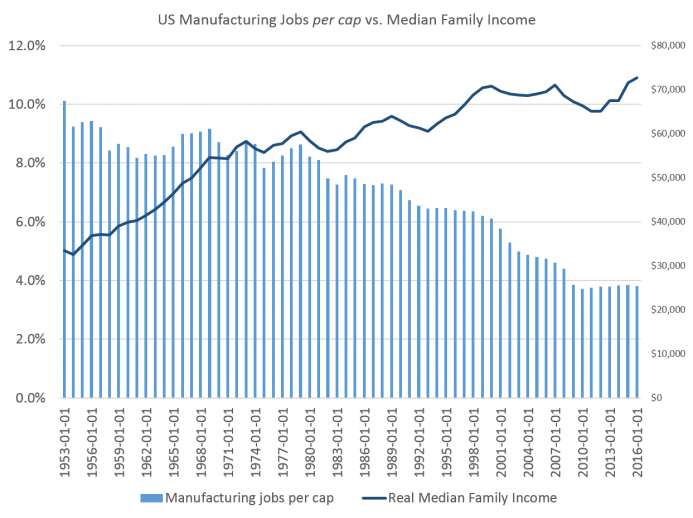One of the reasons that Donald Trump gives for slapping new protectionist tariffs on steel and aluminum is that it will create manufacturing jobs, and by extension, greatly enhance income growth and standards of living in the United States.
Trump is capitalizing on an enduring myth of American economic history in which it is believed that declines in manufacturing jobs are accompanied by drops in standards of living as well.
What is often forgotten, however, is that manufacturing jobs, in proportion to the population overall, dropped significantly from the end of World War II through the 1950s and 1960s. And yet, during this time, real median incomes in the United States increased.

Incomes stagnated somewhat during the 1970s, but then grew substantially again during the 1980s and 1990s. And, of course, during the 1980s and 1990s, manufacturing jobs continued a fast downward slide.
In other words, it is not at all clear that falling manufacturing jobs lead to falling incomes or falling standards of living.
Now, pointing out some correlations — or lack thereof — in the data doesn’t prove that manufacturing jobs have no connection at all to incomes and wealth. To understand that, we need good economic theory. And, on this point sound economics is clear. Higher taxes — i.e., tariffs — are not the way to economic growth. But, when this is pointed out, proponents of higher tariffs say “but history proves that tariffs are great for American!” Well, history “proves” no such thing.
Jobs or Output?
When we talk about manufacturing jobs, though, it’s important to note that we’re not necessarily talking about manufacturing output.
It’s entirely possible for manufacturing output to increase even while manufacturing jobs are falling.
This should be obvious, of course, to anyone familiar with the history of agriculture in the United States. In the 18th century, nearly all Americans were involved in the production of agricultural products. By 2008, only two percent of Americans worked in the Agriculture sector, even though American agricultural output is now many times larger than what it was in the 19th century, or even during the mid 20th century.














Leave A Comment